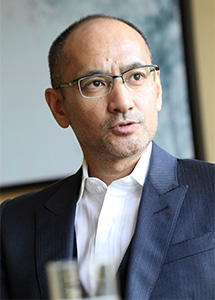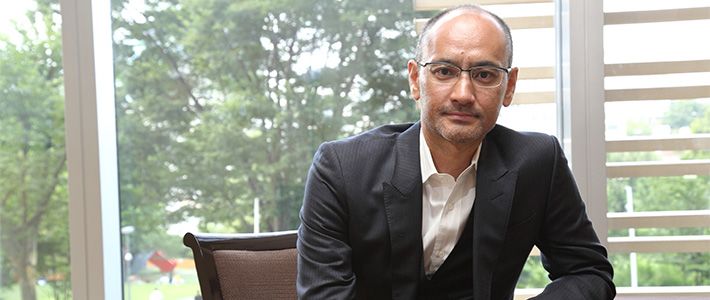
“Villain” Author Enters a World of Rage
Culture- English
- 日本語
- 简体字
- 繁體字
- Français
- Español
- العربية
- Русский
Inspired by a Real-life Murder Case
In 2007, Lindsay Ann Hawker, a young British woman working in Japan as an English teacher, was murdered in the city of Ichikawa in Chiba Prefecture. Ichihashi Tatsuya, the chief suspect, spent most of the next three years on the run, moving around the country and changing his appearance with the help of plastic surgery. The case, and the photographs released to the press that showed Ichihashi’s dramatically altered appearance, caused a sensation. Many people contacted the police with leads before Ichihashi was finally apprehended in November 2009, but most of this information turned out to concern completely different people.
Best-selling author Yoshida Shūichi, whose 2007 novel Akunin (translated into English as Villain) was made into a film in 2010, was inspired by the transformation of the murderer in the Hawker case. The result was the novel Ikari (Rage), originally serialized in a newspaper and published in hardback in 2014. Vividly depicting the tangled human relationships surrounding a mysterious murder, the novel is a disturbing read that leaves a lasting impression.
In the story, a young married couple are murdered one day at the height of summer in Hachiōji, in western Tokyo. Written in blood at the scene of the crime is the kanji character for “anger.” A year later, three mysterious men appear in Tokyo, Chiba, and Okinawa, each of them vaguely resembling the “Wanted” photographs issued by the police in connection with the Hachiōji murder. Is one of them the murderer? The story does not focus on the psychology of the killer or the drama of flight and pursuit. Instead, Rage is interested in the complex thoughts and actions of the various characters who come into contact with the three men. What is it like to suspect that the man you love and trust is really a cold-blooded murderer?
Several of the author’s books have already been filmed, and this September sees the release of a movie version of Rage directed by Lee Sang-il, who also helmed Villain. In the run-up to this anticipated release, we spoke to Yoshida about the background to the story and the sources of his inspiration.
Settings Come First
Since making his debut in 1997 with Saigo no musuko (The Last Son), and winning the Akutagawa Prize in 2002 for Pāku raifu (Park Life), Yoshida Shūichi’s work has covered everything from romance to crime, ranging in genre from “pure” literary fiction to popular entertainments. The author himself says he sensed a change in the way he sees the world around the time he wrote Villain. He was 37 at the time, and he sees that novel as marking the start of an expansion in the range and scope of his fictional worlds.
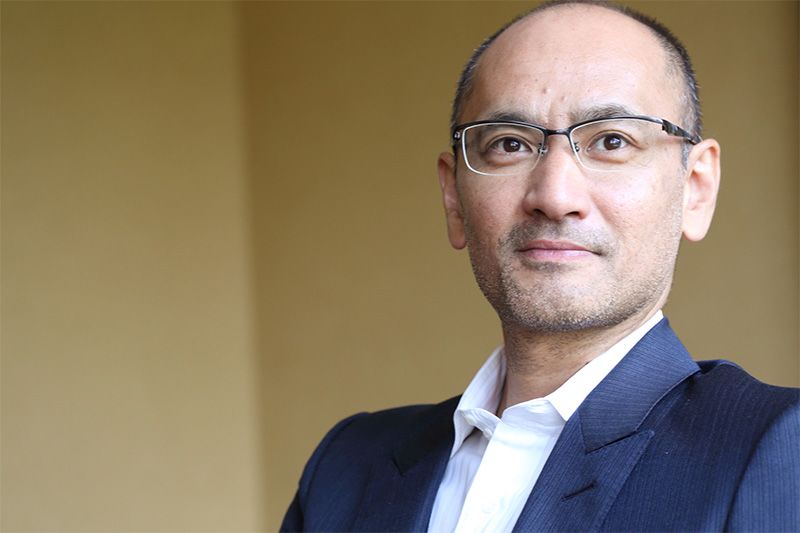 “The scope of my fictional worlds expanded with Villain.”
“The scope of my fictional worlds expanded with Villain.”
“Writing doesn’t always go according to plan. You might have an idea for the kind of thing you want to write or the kind of world you’d like to describe next, but things don’t always work out that way. You can’t write anything until the world inside you expands sufficiently to make it possible. I did get impatient sometimes. If you’re trying to run a marathon, for example, there are training programs you can follow to help you run faster. If you stick to your program, you might be able to finish within four or three hours, or whatever your aim might be. But in the case of a novel, there is no alternative but to simply go on living and writing day after day. There is no doubt that the scope of the fictional worlds I can depict in my writing expanded with Villain, even though I wasn’t aware of any sudden change. But five, ten years after making my debut, I had finally built up the strength I needed to write that kind of book.
“With all my stories, the thing that comes first is the setting. Then I try to come up with characters who will fit that setting.” Yoshida says he is driven by an urge to find out more about his characters as he writes. He often sets his stories in places he has visited. Rage takes place in three main locations: the Bōsō peninsula in Chiba Prefecture, Shinjuku in downtown Tokyo, and a small island in Okinawa.
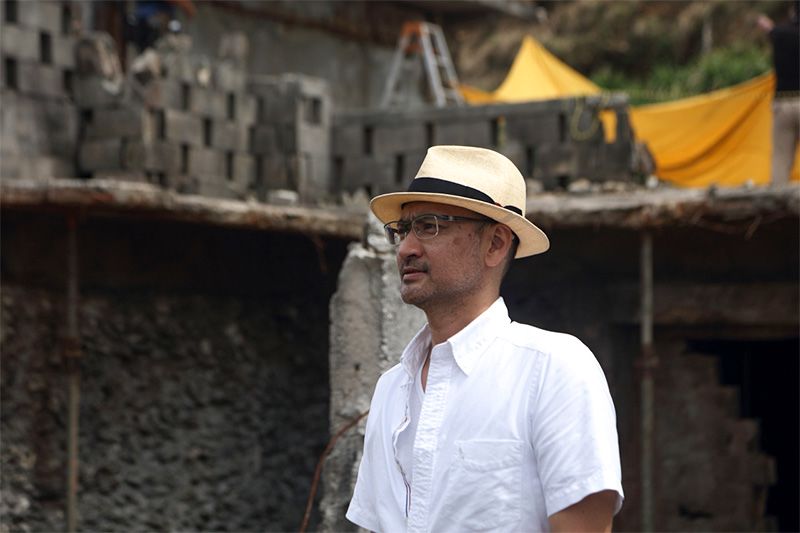 Yoshida on location in Okinawa in September 2015. © Ikari Production Committee
Yoshida on location in Okinawa in September 2015. © Ikari Production Committee
Yoshida says that seeing his novels turned into films often brings home to him how beautiful these locations are. Seeing Villain brought to the big screen served as a reminder of the rugged beauty of northern Kyūshū in winter. This time, he says he was particularly struck by the sight of the mountains seen from the Chiba fishing port, the beauty of the sea around Okinawa, and the spectacle of Tokyo at night. “You have these amazing settings, and various human dramas unfolding within them. That’s what drew me to write about them.”
As the story shifts between Chiba, Okinawa, and Tokyo, it reminds us that situations unfolding in various parts of the country do not take place in a world cut off from our own lives. Anyone could end up in the same situation. To what extent is it possible to get inside another person’s life? And to what extent can we believe in love and friendship? These are the questions confronting the characters in Yoshida’s story.
Looking Beyond the Killer’s Motive
Yoshida says he started writing without knowing which of the three young men was the fugitive killer, Yamagami Kazuya. “At first, I was racking my brains trying to figure out which of them would make the most convincing Yamagami, and constantly trying to work out his motive.” But at a certain point, Yoshida says his focus shifted. “I came to feel that the question of why this person had killed someone was not really at the center of the story I wanted to tell. In the end, I never did figure out why he committed the murder, even though I am the author of the story. Of course, it would have been easy enough to pretend that I did know, but I decided not to do that. Sometimes in life, things happen without any clear motive.”
“While the story was being serialized, I included testimonies by Yamagami’s parents and friends. But I decided to omit these sections when it came time to publish in hardcover. Ultimately I felt that they were not necessary for Rage as a story.”
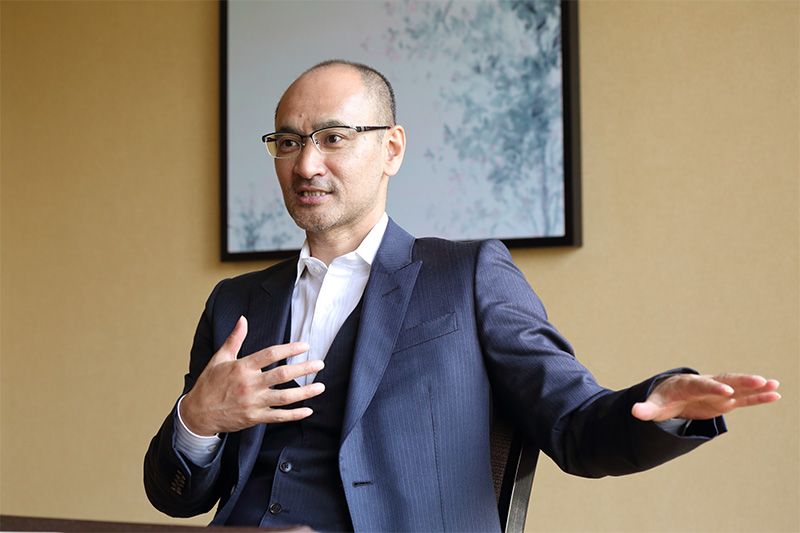 “Sometimes murders happen without any clear motive.”
“Sometimes murders happen without any clear motive.”
The spiritual darkness inside the man who writes the word Rage in blood at the scene of his crimes remains unknowable. It could be said that the novel is not primarily interested in looking for the roots of the anger that propels the murderer, but rather in depicting the different types of anger that mark the lives of those around the three young men: anger directed at the self for not being able to trust other people close to them and anger caused by betrayal of trust. The novel is imbued with a profound sense of the claustrophobia and unease that permeates modern contemporary society, in which people find it difficult to have faith in one another.
“Perhaps in the past people used to be more open when someone moved in next door, for example. They assumed that their new neighbor was someone they could identify with, and felt safe in taking the initiative to open communication. But the social environment has changed. People tend to shrink back from making contact if a foreigner moves in next door, for example. Part of the reason is anxiety about the right way to behave. As the surrounding world grows wider and more open, people themselves find it hard to step forward. There’s the problem of delicacy. It’s difficult.”
Putting Together an All-Star Cast
Director Lee Sang-il has worked with Yoshida in the past, cooperating with him on the script and production during the adaptation of Villain, released in 2010. Lee says, “We live in an age in which people find it difficult to trust one another. Yoshida-san is struggling against this alone, using the form of the novel. I felt I needed to take that baton from him and bring the message out into the world on the movie screen,” he said at a press conference held to mark the completion of filming on July 11 this year.
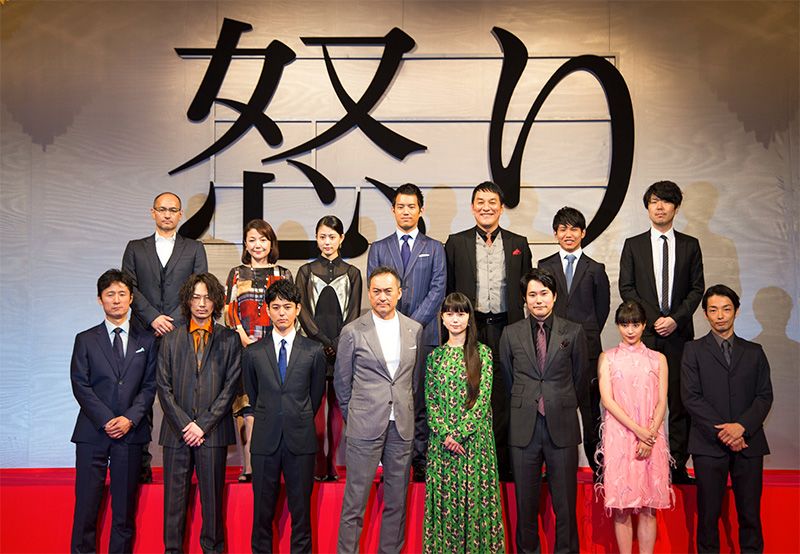 The cast and crew at a press conference in July 2016. Director Lee Sang-il is on the left of the front row. Behind him is Yoshida Shūichi. (Photograph by Ōtani Kiyohide)
The cast and crew at a press conference in July 2016. Director Lee Sang-il is on the left of the front row. Behind him is Yoshida Shūichi. (Photograph by Ōtani Kiyohide)
Yoshida comments, “I’m a novelist, and he’s a director. If there’s something we want to say about the state of the world, it’s going to come out in our work. The fact that even one person appreciates what I’m trying to do the way he does makes me feel that writing the book was worthwhile. My hope is that what I was trying in the book will be conveyed to the people who come to see the film.”
Knowing that he could trust Lee’s opinion, and feeling that Rage contained elements that linked it with Villain, Yoshida sent the director an advance copy of the book and asked him for his impressions. Lee said he wanted to film it, and Yoshida told him he would want an all-star cast along the lines of the ensemble in the Hollywood remake of Ocean’s Eleven. “I felt intuitively that filming Rage would be harder than was the case with Villain. We needed a “weapon” to help us make the film a success, and I had the idea of an all-star cast. The film was going to depict people leading untypical lives in all three of our settings, in Chiba, Tokyo, and Okinawa, and I felt it would be significant to have well-known actors play those roles.”
In the movie version of Rage, international star Watanabe Ken plays the part of Maki Yōhei, an employee in the local fishing cooperative in a fishing port in Chiba, who is worried about his daughter’s involvement with a mysterious man no one seems to know anything about. Tsumabuki Satoshi—who rose to fame in the 2001 comedy Wōtā bōizu (Waterboys)—and Ayano Gō play a gay couple, alongside numerous other stars who give wonderful performances in roles that challenge their existing public image. The music is by Sakamoto Ryūichi. Yoshida himself says he enjoys Japanese and foreign films of all genres. “My first impression when I saw this film, not as the author of the story but as a movie fan, was that this was a Japanese movie like nothing I had never seen before,” he says.
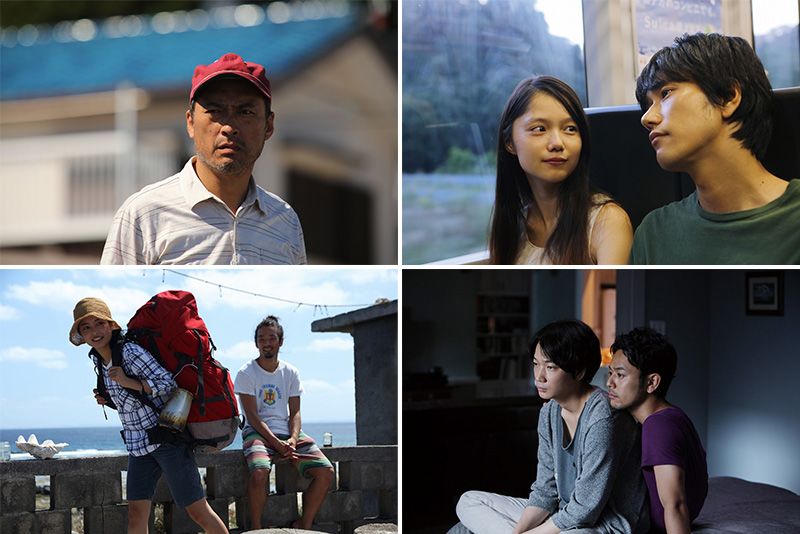 (Clockwise from upper left: After losing his wife, Maki Yōhei (Watanabe Ken), a fishing cooperative employee in Chiba, has brought up his daughter alone; having been brought back home by her father from Tokyo, where she was working in the sex industry, Aiko (Miyazaki Aoi) falls in love with Tashiro Tetsuya (Matsuyama Ken’ichi) , a man who recently started working alongside Maki. Fujita Yūma (right, Tsumaki Satoshi), who works at a major advertising firm, is drawn to Ōnishi Naoto (Ayano Gō) when they meet in Shinjuku, and the two men start living together. Komiyama Izumi (Hirose Suzu) has moved to a small island in Okinawa with her mother when she encounters a backpacker calling himself Tanaka Shingo (Moriyama Mirai) on an inhabited island and finds herself drawn to this mysterious stranger. © Ikari production committee.
(Clockwise from upper left: After losing his wife, Maki Yōhei (Watanabe Ken), a fishing cooperative employee in Chiba, has brought up his daughter alone; having been brought back home by her father from Tokyo, where she was working in the sex industry, Aiko (Miyazaki Aoi) falls in love with Tashiro Tetsuya (Matsuyama Ken’ichi) , a man who recently started working alongside Maki. Fujita Yūma (right, Tsumaki Satoshi), who works at a major advertising firm, is drawn to Ōnishi Naoto (Ayano Gō) when they meet in Shinjuku, and the two men start living together. Komiyama Izumi (Hirose Suzu) has moved to a small island in Okinawa with her mother when she encounters a backpacker calling himself Tanaka Shingo (Moriyama Mirai) on an inhabited island and finds herself drawn to this mysterious stranger. © Ikari production committee.
The Experience of Being Read Overseas
Although his international reputation may not yet rival that of Murakami Haruki, many of Yoshida Shūichi’s works have appeared in translation. How does he feel about his works being read by people in other countries?
“For the past ten years or so, whenever a new book has been published in Japan, it’s been translated almost immediately in South Korea, Taiwan, and China. So I’ve started to become aware of my international readership to some extent. In the past, for example, I used to write quite casually of ‘the Chinese’ without really thinking about what I was saying. Now I’m more likely to think, ‘hold on, Chinese people are going to read this.’ So I’ve become quite aware how much I used to use nationality and things as symbols in the past.”
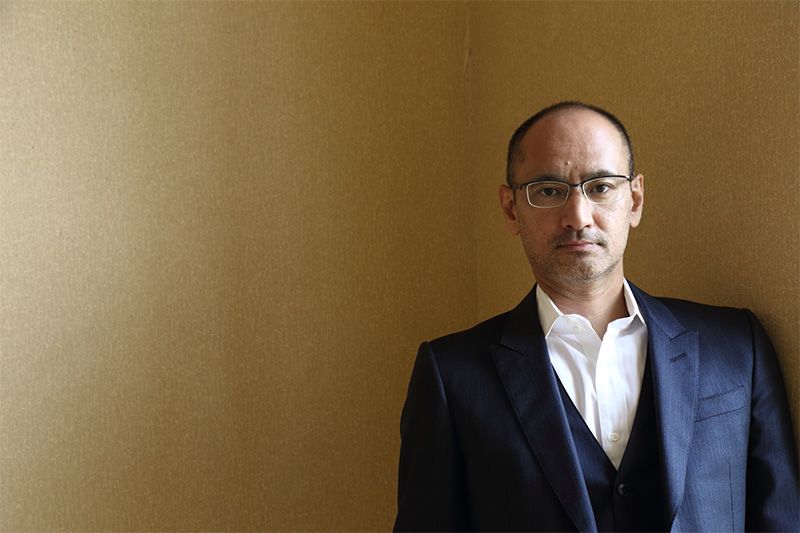 Most of Yoshida’s works have been translated into Chinese and Korean.
Most of Yoshida’s works have been translated into Chinese and Korean.
Villain was the first of Yoshida’s novels to be translated into English. Yoshida says he was happy to see his book compared to the bestselling crime novels of the Swedish author Stieg Larsson when the book was reviewed in the online edition of the Wall Street Journal.
Rage has a lot in common with Villain in terms of genre, as a psychological thriller full of mystery. It will surely attract a wide readership if it is translated into English, and the story seems perfect for a Hollywood remake that would see it distributed around the world.
“In today’s world, a story can work universally anywhere. I’m not just thinking of this particular story. You could take a story originally set in Seoul and relocate it to Tokyo without any difficulty. People’s lives are more or less the same in Europe or America or wherever they might be. I was in New York recently having a coffee in Starbucks when it suddenly struck me that I was basically doing exactly the same thing as I would have been doing in Tokyo. In today’s world, people’s lives and the things they feel are not that different, wherever they happen to live.”
Perhaps it is this conviction that writing about lives in contemporary Japanese society is of universal relevance that makes Yoshida’s stories seem so natural and unaffected, and helps to give them such a widespread appeal.
(Originally written in Japanese by Itakura Kimie of Nippon.com and published on September 15, 2016. Photographs by Hanai Tomoko unless otherwise stated.